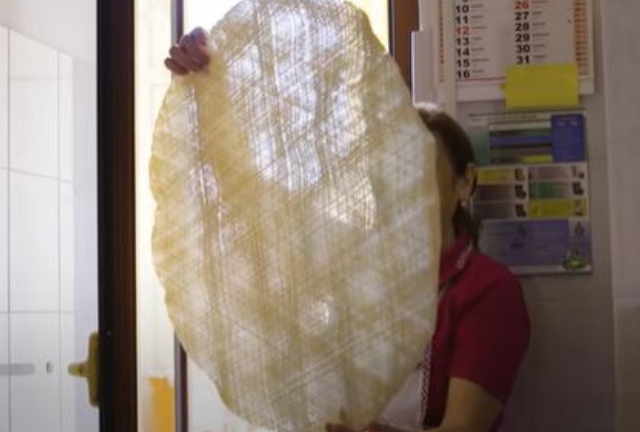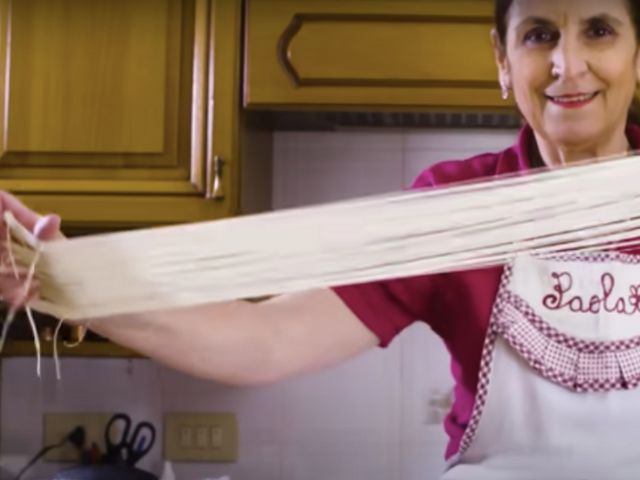
-
‘Threads of God’ – A Look At The World’s Rarest Pasta That You Have To Walk 32km To Eat [Video]
18 Aug 2023 by Maya-Rose Torrao in Lifestyle, Video, World
[imagesource:youtubescreenshot]
In the quiet corners of Sardinia, a pilgrimage unlike any other unfolds, weaving a tapestry of tradition, devotion, and culinary craftsmanship.
Twice a year, a determined assembly of pilgrims embark on a journey to Santuario di San Francesco, a sanctuary nestled in the village of Lula, Sardinia. However, it’s not the location itself that pushes hikers to haul their bodies 32km to the destination but an elusive hand-made pasta.
Shrouded in mystique and named “su filindeu,” meaning “threads of God” in Sardo, a recipe that’s been passed down for generations on this quaint Mediterranean island.
A pasta with a history so great that its name invokes holy images of beams of godly light? As a carb-lover, count me in. The only problem is, how does one actually get there?
The voyage to Santuario di San Francesco is no stroll. Pilgrims traverse the twenty miles (32km) from the city of Nuoro to Lula under the cover of night. The dedicated foodies-on-foot forsake sleep and shelter to partake in a centuries-old tradition. For over two centuries, the biannual Feast of San Francesco has been marked by the creation of this pasta, made by the hands of just three women – the only three people on the entire planet who know how to make it.
Su filindeu’s ingredients are unassuming—semolina wheat, water, and salt. But the allure of these holy noodles is not just about the ingredients; the technique involved is almost impossible to replicate.
[image:youtube/screenshot]
Even engineers from the renowned Barilla pasta company grappled in vain to construct a machine capable of replicating the technique. The puzzle of su filindeu also proved too complex for celebrated celebrity chef Jamie Oliver, who, after two hours of trying, conceded defeat. Sorry Jamie, the OG tannies take the win on this one.
Paola Abraini, who possesses an intimate understanding of su filindeu’s elusive essence, is one of the master craftswomen who can create the dish. Apparently the key lies in sensing the dough with her hands, an intuition that many just simply don’t have. Through meticulous kneading and layering, she achieves the perfect consistency, stretching the dough into 256 ethereal threads that flutter like silk strands on a loom.
It’s mesmerising just watching Abraini and her precious pasta:
Gently crisscrossing three layers of these fragile strings over a circular wooden frame, the strands are then left to bask in the sun, a ritual that captures the essence of Sardinia’s rustic charm.
After seeing the heart, community and ancestry that are entangled in the tapestry of ‘Threads of God’, I reckon it’s well worth the trek. Abraini is a rare artist, combining gastronomy and culture into a delicious bundle of light and joy.
[source:altaobscura]
Latest News
-
Thai Woman Sentenced To Death For Murdering 14 Friends With Cyanide In Shocking Killing Spree
[imagesource: Sararat Rangsiwuthaporn] A woman in Thailand, dubbed 'Am Cyanide' by Thai...
-
René Magritte Painting Sells For Record R2.1 Billion At Auction
[imagesource:renemagritte.org] A René Magritte painting portraying an eerily lighted s...
-
Brave Rape Survivor Alison Botha Faces New Challenge After Brain Surgery
[imagesource: Alison Botha] Gqeberha rape survivor Alison Botha, a beacon of resilience...
-
Get Ready For The Mother of All Celebrations As MCQP Turns 30
[imagesource:mcqp/facebook] Clutch your pearls for South Africa’s favourite LGBTQIA+ ce...
-
The Iconic Good Hope Centre Is Set For Redevelopment
[imagesource:capetown.gov] The City of Cape Town’s Mayoral Committee has approved the...
-






























